How Does eBay Make Money? eBay Business Model Deep Dive 2025!

As one of the pioneering giants of the e-commerce era, eBay has carved out a unique niche in the online marketplace. Unlike traditional online retailers, eBay functions as a global auction and consumer-to-consumer platform, offering everything from vintage collectibles to brand-new electronics. Since its founding in 1995, eBay has remained resilient and relevant amid a rapidly evolving digital commerce landscape. But here’s the million-dollar question: How does eBay make money? What is the engine behind this online marketplace, and how does its business model work in 2025? More importantly, what can eCommerce sellers and retailers learn from it? In this article, we’ll break down eBay’s entire business model, analyze its revenue streams, and explore key financial metrics.
Let’s dive in.
>> You may also like:
- Best eBay Alternatives For Sellers To Consider in 2025
- Temu business model analysis: How does Temu make money?
- Wayfair Business Model: How Does Wayfair Make Money?
What is eBay?
eBay is a multinational e-commerce platform that facilitates consumer-to-consumer and business-to-consumer sales through its website and mobile applications. Operating as an online marketplace, eBay allows individuals and businesses to buy and sell a wide variety of goods and services worldwide. The platform serves as an intermediary between buyers and sellers, providing the infrastructure, payment processing, and trust mechanisms necessary for secure online transactions. With operations spanning over 190 markets globally, eBay has established itself as one of the most recognized brands in e-commerce, handling billions of dollars in gross merchandise volume annually.
eBay Development Milestones
- 1995: eBay was founded by Pierre Omidyar as “AuctionWeb,” an online auction site that enabled peer-to-peer transactions – a novel concept at the time.
- 1998: eBay goes public with an IPO, raising over $60 million and quickly becoming one of the standout tech companies of the dot-com boom.
- 2002: eBay acquires PayPal, integrating one of the most trusted online payment methods directly into its platform, significantly improving transaction security and convenience.
- 2015: eBay spins off PayPal into an independent company, allowing both entities to focus on core innovations – marketplace and fintech, respectively.
- 2020: eBay launches its Managed Payments system, streamlining the payment process and capturing additional revenue from payment-related services.
- 2022: The company acquires TCGplayer, a move aimed at strengthening its position in the high-growth collectibles and trading card niche.
- 2023: eBay introduces AI-powered listing tools to simplify and automate product listings, improving seller efficiency and listing quality.
- 2025: eBay doubles down on strategic verticals such as luxury fashion, refurbished electronics, and authenticated collectibles – areas with high margins and growing demand.
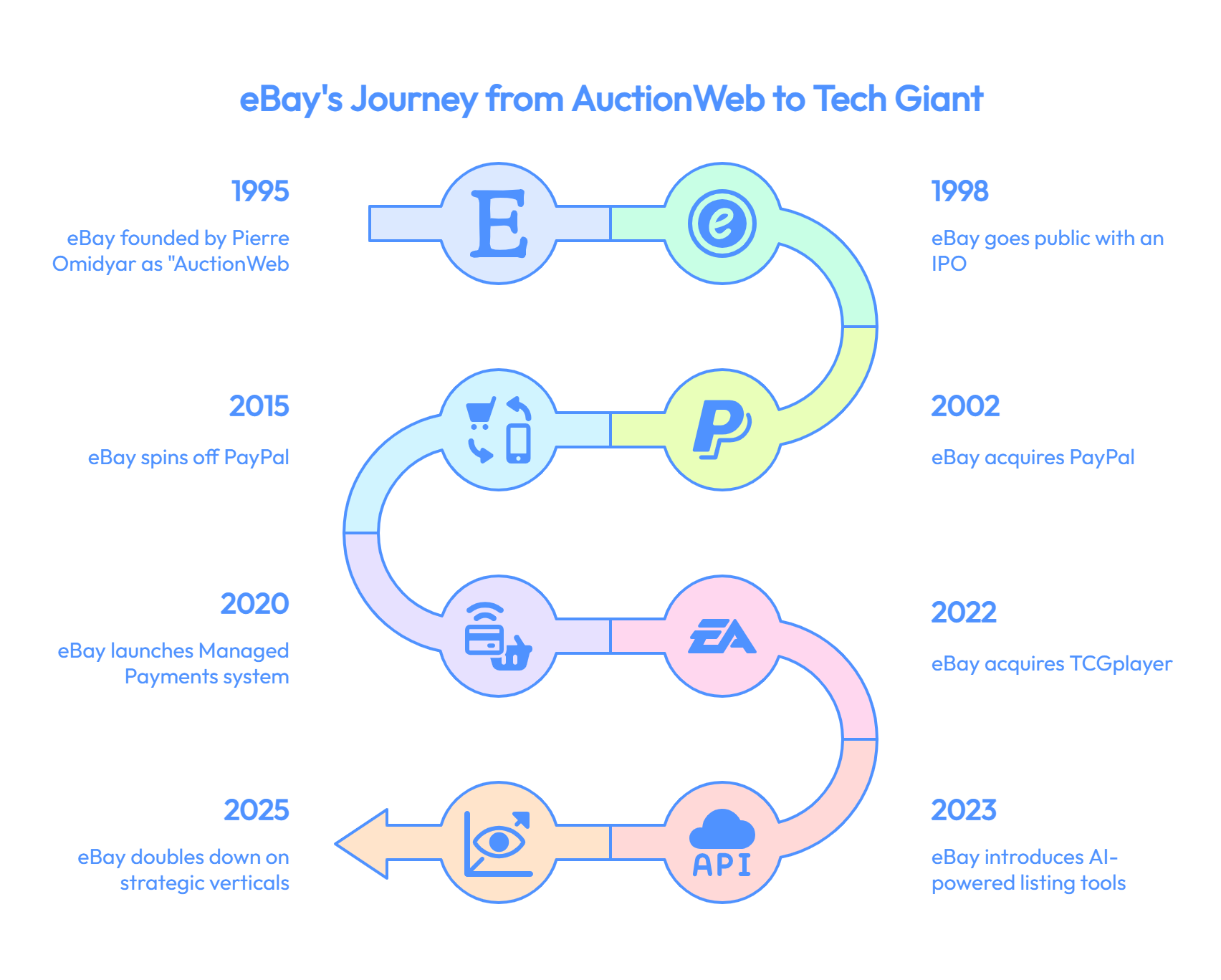
eBay Business Model Canvas Deep Dive Analysis
eBay’s business model operates on a sophisticated framework that balances the needs of buyers and sellers while generating sustainable revenue. Let’s analyze each component of their business model canvas to understand how these elements work together to create value.
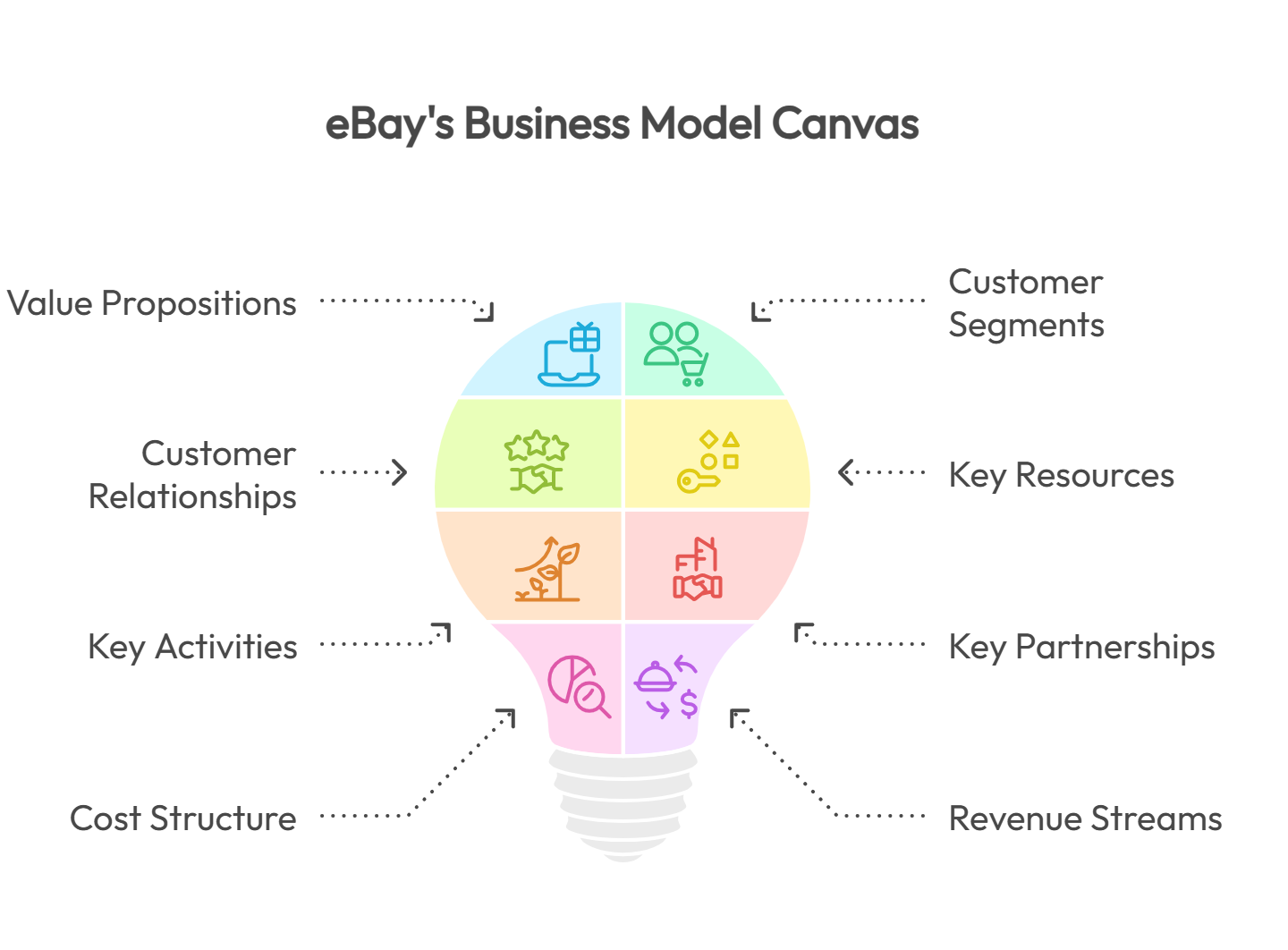
Value Propositions
eBay’s value proposition centers on creating a trusted marketplace where buyers can find unique, rare, and competitively priced items while sellers can reach a global audience with minimal setup costs.
For buyers, eBay offers a vast and unique selection, with over 2.3 billion active listings globally as of Q1 2025, representing a 15% increase from 2023. The platform provides competitive pricing and the engaging choice of both auction and “Buy It Now” formats. To build trust, eBay implements key mechanisms such as Buyer Protection, offering up to $50,000 in coverage with a 98.6% resolution rate. The Authenticity Guarantee service, expanded to include luxury items like watches and jewelry in Japan, further reinforces trust and selection for high-value goods. Additionally, the platform supports flexible payment options through strategic partnerships, such as with Klarna, offering “Pay in 4” and financing options.
For sellers, eBay provides unparalleled global reach to its 134 million active buyers. It offers comprehensive tools for independent listing and personal selling account management , along with various pricing formats (auction and fixed-price). Seller Protection, providing up to $10,000 in coverage with a 97.2% resolution rate , and the robust, community-driven feedback system (with 87% user participation) are critical for building trust and accountability. Recent innovations, including AI-powered “Magic Listings” and bulk listing tools, are designed to streamline the selling process, improving listing quality and efficiency for sellers. eBay University also continues to support new sellers by helping them find their footing in the global marketplace.
Customer Segments
eBay serves multiple distinct customer segments that contribute to its revenue generation. On the buyer side, eBay connects with 134 million active buyers worldwide across more than 190 markets as of Q1 2025. These buyers are often seeking value, unique selection, and a significant portion are interested in pre-loved or refurbished items, with 86% stating that buying pre-loved goods drives sustainability. Mobile shopping is particularly prevalent among younger users, with nearly 75% of mobile shoppers aged 18-34, while a notable 14.3% are 55 or older. Geographically, the United States accounts for the majority of eBay’s traffic, comprising 69.83% of visits.
For sellers, eBay caters to a diverse range, from casual individuals looking to declutter to small businesses (SMBs) and professional merchants. As of Q1 2025, there are 20 million sellers on the platform. In 2023, 1.7 million active small business sellers contributed a substantial $87.4 billion in merchandise volume, complemented by 250,000 professional merchants generating $42.6 billion. A significant motivation for many sellers (58%) is to make additional income from selling pre-owned items, a process that 64% of sellers report has become easier in recent years.
Customer Relationships
eBay fosters a strong, largely self-regulating, community-driven ecosystem, with 87% of users regularly participating in feedback mechanisms. This includes active community forums and user discussion boards where users can share insights, provide support, and collaborate. The iconic feedback system, first introduced in 1996, remains central to building trust and accountability between buyers and sellers. Sellers are actively encouraged to maximize positive reviews, as these significantly influence buyer decisions and enhance credibility.
eBay provides comprehensive tools and support for its sellers, such as the redesigned Seller Hub, which offers valuable analytics into sales performance, buyer behavior, and listing effectiveness. eBay University continues to offer training and resources for new sellers, helping them navigate the platform. There is a clear emphasis on improving seller performance standards, particularly in areas like handling times, return policies, and buyer satisfaction scores, which are crucial for maintaining a high-quality marketplace.
Robust protection mechanisms, including Buyer Protection (with up to $50,000 coverage) and Seller Protection (with up to $10,000 coverage) programs, provide a crucial safety net. These programs help resolve disputes and foster confidence in transactions, which is especially important for a consumer-to-consumer (C2C) marketplace.
Increasingly, eBay is leveraging artificial intelligence (AI) to personalize recommendations for buyers, streamline the listing process for sellers, and enhance customer support interactions, aiming for a more modern and seamless customer journey. eBay also actively seeks and responds to feedback from its seller community, incorporating suggestions for platform improvements, such as calls for better search algorithms, U.S.-based customer service, and more flexible sales tools.
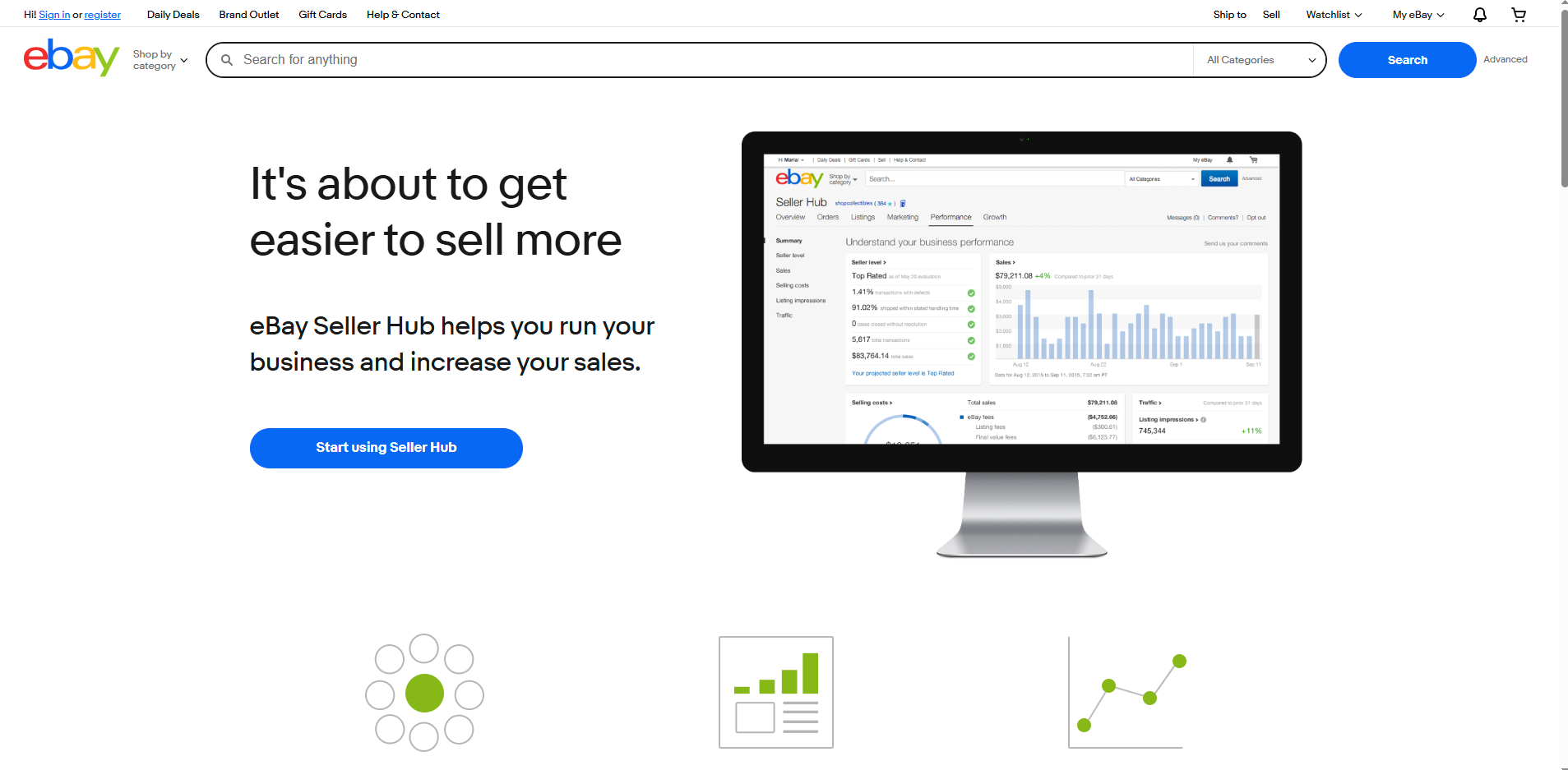
Key Resources
eBay’s operations are underpinned by a robust and scalable Technology Infrastructure, capable of handling over 2.3 billion live listings globally and facilitating real-time transaction processing. This infrastructure includes a distributed cloud network across six global data centers. eBay made significant investments in this area, dedicating $612 million to research and development (R&D) in 2023, with an annual technology investment totaling $2.3 billion in the same year. Its machine learning algorithms are highly sophisticated, processing 4 petabytes of data daily to optimize various platform functions.
The company benefits from a strong Brand Value & Recognition. eBay holds an $8.2 billion brand value, enjoys 94% global brand recognition among online shoppers, and maintains a trust score of 8.6/10 among e-commerce platforms. Its reputation for innovation is further solidified by being named to Fortune’s “Most Innovative Companies” list for 2025 for the third consecutive year.
A critical asset is its Vast User Base & Network Effect, comprising a massive and engaged network of 134 million active buyers and 20 million sellers spread across more than 190 markets. This inherent network effect, where an increasing number of users naturally attracts even more users, provides a significant competitive advantage.
eBay’s ability to collect, analyze, and leverage vast amounts of transaction and user behavior data forms its Data & AI Capabilities. This extensive data fuels AI-powered tools such as “Magic Listings” for sellers, which automates and optimizes listing creation, and personalized recommendations for buyers, significantly enhancing platform efficiency and user experience.
Finally, its Human Capital is a vital resource, including a dedicated team of 4,200 technology professionals and an experienced management team, all crucial for driving innovation and operational excellence
Key Activities
eBay’s primary activities focus on platform maintenance and enhancement, user acquisition and retention, trust and safety operations, and market expansion. The company continuously develops new features and tools to improve user experience, implements fraud prevention measures, and maintains customer support operations across multiple markets. Marketing activities include digital advertising, partnerships, and promotional campaigns to attract new users and retain existing ones. eBay also manages relationships with logistics partners, payment processors, and regulatory bodies across different jurisdictions. These activities ensure platform stability, user growth, and regulatory compliance, all of which are essential for maintaining the transaction volume that drives eBay’s revenue.
Key Partnerships
eBay’s partnership ecosystem includes payment processors beyond their historical PayPal relationship, shipping companies like UPS and FedEx for integrated logistics solutions, authentication services for luxury goods and collectibles, and technology partners for platform enhancement. Strategic partnerships with major brands and retailers help expand inventory and attract professional sellers. eBay also collaborates with government agencies and law enforcement for regulatory compliance and fraud prevention. These partnerships enhance the platform’s value proposition, reduce operational costs, and expand service capabilities, ultimately supporting higher transaction volumes and revenue generation through improved user experience and trust.
Cost Structure
eBay operates with a cost structure focused on technology infrastructure, personnel, marketing, and operational expenses. Major cost categories include platform development and maintenance, data center operations, customer support, sales and marketing activities, and regulatory compliance. The company benefits from economies of scale where increased transaction volume spreads fixed costs across more users, improving profitability. eBay’s variable costs remain relatively low compared to traditional retailers since they don’t hold inventory or manage physical fulfillment for most transactions. This cost structure enables high margins on incremental transactions and supports the scalable nature of the marketplace model.
Revenue Streams
eBay generates revenue through multiple streams that capitalize on platform usage and transaction volume. Transaction fees represent the largest revenue source, including final value fees (a percentage of the total sale amount) and insertion fees for listing items, with rates varying by product category and seller status. Additional revenue comes from advertising services where sellers pay for promoted listings and enhanced visibility, payment processing fees through managed payments, subscription services for high-volume sellers, and ancillary services like authentication and shipping tools. This diversified revenue approach reduces dependence on any single income source while creating multiple ways to monetize platform usage.
Channels
The primary channel for eBay is its online platform, eBay.com, which is globally accessible and operational in over 190 countries. The platform receives more than 700 million monthly visits, with traffic split between desktops (48.55%) and mobile devices (51.45%).

Mobile applications represent a crucial and growing channel, particularly appealing to younger demographics, with nearly 75% of mobile shoppers falling within the 18-34 age range. The eBay app recorded 2.9 million downloads on the Google Play Store in December 2024, with a noticeable peak of 3.7 million downloads in September 2024. Recognizing the importance of mobile, eBay is actively developing a dedicated “Sell Mode” for its mobile app, designed to provide a customized selling experience and enable on-the-go business management for sellers.
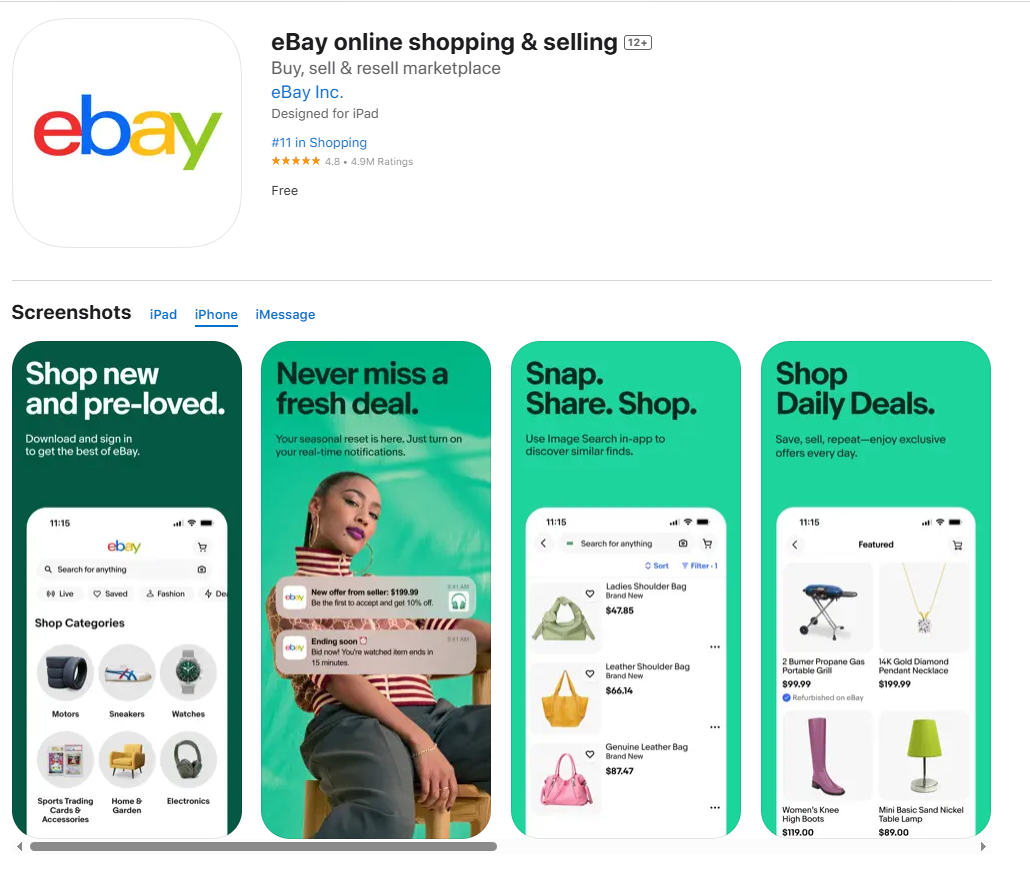
eBay employs extensive direct marketing strategies, including sending 2.7 billion marketing emails monthly, which achieve a 19.2% open rate and a 4.3% conversion rate.
Beyond its owned platforms, eBay maintains a strong social media presence, boasting 12.4 million followers on Facebook and 3.6 million on Instagram. It further expands its reach through strategic partnerships, such as the integration with Facebook Marketplace in the U.S., Germany, and France, which broadens seller visibility and allows access to new audiences. A collaboration with OpenAI’s AI agent “Operator” also directs users to eBay’s unique inventory when relevant to their search queries.
For specialized experiences, eBay offers “eBay Live,” a platform for real-time livestream shopping and “Breaks” for collectibles like trading cards, creating engaging, interactive sales channels for specific categories and fostering community participation.
Looking to level up your customer experience like eBay? A mobile app could be your next big step. With SimiCart’s mobile app builder, you can easily create a fully branded, feature-rich shopping app without writing a single line of code. It’s a simple way to boost sales, build stronger customer loyalty, and stay connected with your audience wherever they go. Try SimiCart today and see the difference a mobile app can make!
How Does eBay Make Money: Detail About eBay Revenue Streams
Having examined eBay’s comprehensive business model, we can now focus on the specific mechanisms through which the company generates revenue. eBay’s financial success stems from its ability to monetize various aspects of marketplace activity while maintaining competitive advantages that keep users engaged and transacting on the platform.
eBay’s primary revenue generation revolves around transaction-based fees that scale with platform activity. eBay primarily makes money by charging fees on successfully closed transactions, generating $9.79 billion in revenues from $73.9 billion worth of gross merchandise value in 2022, representing a 13.25% take rate. This fee structure aligns eBay’s interests with user success, as the company only earns money when transactions are completed successfully.
Transaction Fees represent the cornerstone of eBay’s revenue model. The platform charges an insertion fee of $0.35 for basic listings on eBay.com, while final value fees range from 10 to 12 percent of the product’s selling amount, including shipping costs. These fees vary by category, with some high-volume sellers receiving reduced rates based on their performance and sales volume. The tiered fee structure encourages seller growth while maximizing revenue from successful transactions.
Advertising Revenue has become increasingly important as sellers compete for visibility. eBay earns commission through Final Value Fees calculated as a percentage of the total sale amount, but also generates significant income from promoted listings where sellers pay for enhanced placement in search results. This advertising model creates additional revenue opportunities beyond basic transaction fees while helping sellers improve their sales performance.
Payment Processing Fees contribute another revenue stream through eBay’s managed payments system. After spinning off PayPal, eBay developed its own payment processing capabilities, allowing the company to capture fees from payment transactions in addition to marketplace fees. This vertical integration increases overall revenue per transaction while providing better control over the user experience.
Subscription Services cater to high-volume sellers who need advanced tools and higher listing allowances. These recurring revenue streams provide predictable income while supporting eBay’s most valuable seller segments. Professional sellers often require additional features like bulk listing tools, advanced analytics, and priority customer support, creating natural opportunities for subscription-based monetization.
Ancillary Services include authentication programs, shipping tools, and seller services that address specific marketplace needs. eBay’s Authenticity Guarantee program, launched for luxury goods and collectibles, generates additional fees while building trust in high-value categories. These services create competitive differentiation while opening new revenue channels beyond basic marketplace operations.
eBay Financial Statistics
Understanding eBay’s financial performance provides crucial insights into the effectiveness of their business model and revenue generation strategies. The company’s financial metrics demonstrate both the scale of their operations and the sustainability of their revenue approach.
eBay Revenue
eBay’s annual revenue for 2024 reached $10.283 billion, representing a 1.69% increase from 2023. This growth demonstrates the platform’s resilience in a competitive e-commerce environment. Quarterly revenue has remained consistent at approximately $2.6 billion, with Q4 2024 showing 1% growth on both as-reported and FX-neutral basis. The stability in quarterly figures indicates a mature business model with predictable revenue streams, though growth rates have moderated compared to earlier years.
The revenue growth trajectory shows eBay’s evolution from a high-growth startup to a stable, mature platform. While growth rates have slowed, the absolute revenue figures demonstrate the significant scale of eBay’s operations and their ability to generate substantial income from marketplace activities. This revenue base provides financial stability for continued investment in platform improvements and new service development.
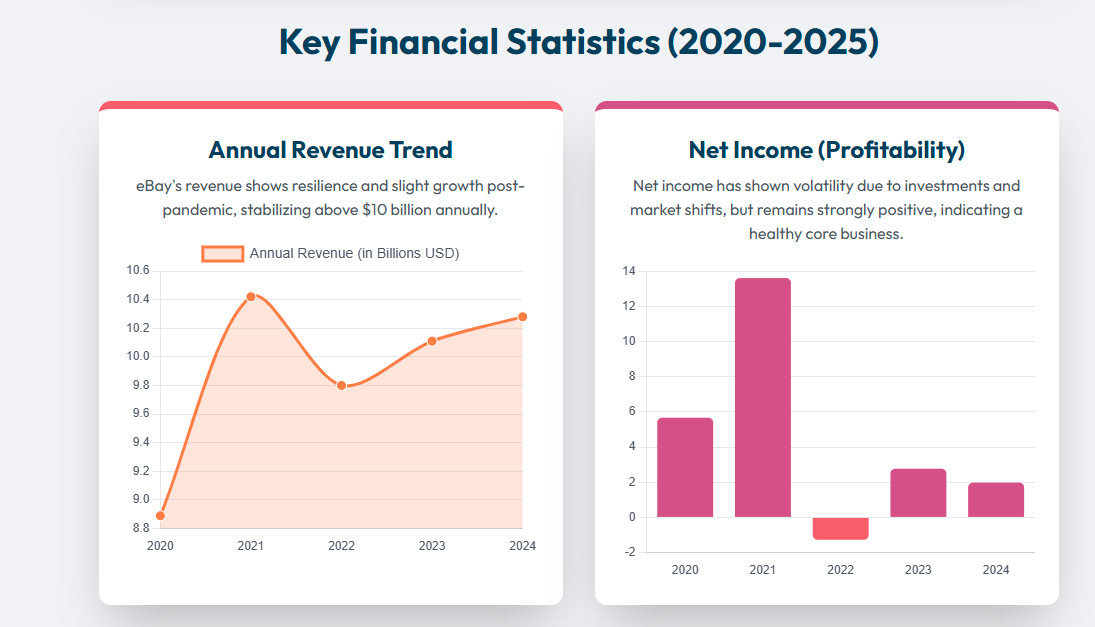
eBay Gross Merchandise Volume
eBay’s Gross Merchandise Volume (GMV) reached $19.3 billion in Q4 2024 (~75 billion in 2024), representing 4% growth on an as-reported basis. GMV represents the total value of goods sold on the platform before eBay’s fees, providing insight into overall platform activity and health. The growth in GMV outpacing revenue growth suggests that eBay’s take rate (percentage of GMV captured as revenue) may be experiencing pressure from competitive dynamics or strategic fee adjustments.
Annual GMV figures demonstrate the massive scale of commerce flowing through eBay’s platform. This volume creates substantial opportunities for fee generation while highlighting eBay’s role as a significant facilitator of global trade. The relationship between GMV and revenue provides insights into eBay’s pricing strategy and competitive positioning in the marketplace economy.
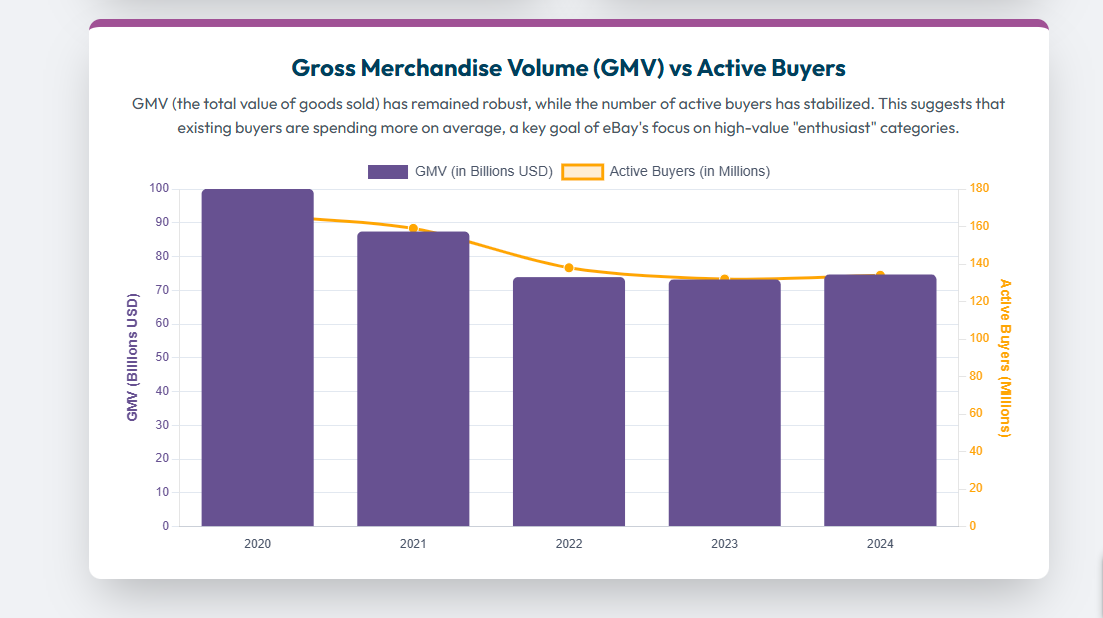
eBay Profitability
eBay reported GAAP earnings per diluted share of $1.40 and Non-GAAP earnings of $1.25 for Q4 2024. These earnings figures demonstrate eBay’s ability to convert revenue into profits, reflecting the scalable nature of their business model. The difference between GAAP and Non-GAAP earnings typically reflects adjustments for stock-based compensation, acquisition-related costs, and other non-recurring items.
eBay’s profitability metrics showcase the advantages of the marketplace model, where the company generates revenue without holding inventory or managing complex fulfillment operations. This asset-light approach enables high margins on incremental transactions while reducing operational complexity compared to traditional retail models.
eBay Net Worth and Market Position
eBay’s market capitalization and financial position reflect investor confidence in the business model’s long-term sustainability. The company’s ability to generate consistent cash flows from marketplace operations provides financial flexibility for strategic investments, acquisitions, and shareholder returns through dividends and share buybacks.
The financial statistics reveal a mature, profitable business with stable revenue generation and strong cash flow characteristics. While growth rates have moderated, eBay’s financial position enables continued investment in platform improvements, new market expansion, and strategic initiatives that can drive future growth and profitability.
FAQs About How Does eBay Make Money
How much money does eBay make per day?
Based on eBay’s 2024 annual revenue of $10.283 billion, the company generates approximately $28.2 million per day on average. However, daily revenue can vary significantly based on seasonal factors, promotional events, and overall e-commerce trends. Peak shopping periods like holidays typically see higher daily revenue figures, while slower periods may generate less than the daily average.
What percentage does eBay take from sales?
eBay’s overall take rate is approximately 13.25% of gross merchandise value, though this varies by category and seller type. Final value fees typically range from 10-12% of the total sale amount including shipping, with additional insertion fees and payment processing charges contributing to the total cost for sellers. High-volume sellers often receive reduced rates, while new or low-volume sellers may pay standard rates.
Does eBay make money from failed auctions?
eBay generally does not generate revenue from failed auctions or unsold listings, as their primary revenue model is based on successful transaction completion. However, sellers may pay insertion fees for listing items regardless of whether they sell, particularly if they exceed their free listing allowances. This creates some revenue from unsuccessful listings, though it represents a small portion of total income.
How does eBay compete with Amazon?
eBay competes with Amazon by focusing on unique value propositions including rare and collectible items, auction-style pricing, individual seller relationships, and lower barriers to entry for sellers. While Amazon emphasizes fast fulfillment and standardized products, eBay’s strength lies in marketplace diversity, competitive pricing through auctions, and serving niche collector communities that Amazon doesn’t address as effectively.
What is eBay’s biggest revenue driver?
Transaction fees represent eBay’s largest revenue driver, generated through final value fees charged on completed sales. These fees scale directly with platform activity and seller success, aligning eBay’s interests with marketplace growth. While advertising and other services contribute meaningfully to revenue, the fundamental transaction-based model remains the primary source of income.
How profitable is selling on eBay?
Seller profitability on eBay depends on multiple factors including product category, pricing strategy, volume, and operational efficiency. Standard sellers typically pay around 10% in fees, while power sellers with good reputations may pay reduced fees of approximately 6%. Successful sellers often achieve healthy profit margins by focusing on niche categories, efficient operations, and building strong seller ratings that can lead to fee reductions and increased buyer confidence.
Is eBay’s business model sustainable?
eBay’s business model demonstrates strong sustainability characteristics through diversified revenue streams, scalable operations, and network effects that strengthen over time. The platform’s ability to generate revenue from both sides of transactions while maintaining relatively low operational costs creates a robust financial foundation. However, continued success depends on adapting to e-commerce evolution, maintaining competitive advantages, and expanding into new markets and service areas.
The company’s consistent profitability, strong cash generation, and ability to return capital to shareholders while investing in growth initiatives suggest a sustainable business model. As e-commerce continues expanding globally, eBay’s marketplace approach provides opportunities for continued revenue growth and market expansion, particularly in international markets and specialized product categories where their unique value proposition remains strong.

